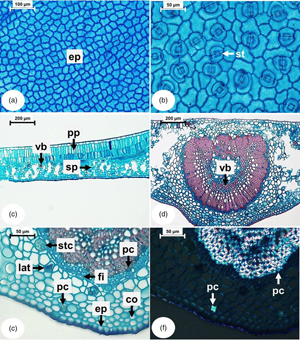Published online by Cambridge University Press: 23 July 2021

Hancornia speciosa Gomes is popularly known as mangabeira and occurs throughout Brazil. It belongs to the Apocynaceae family and is very important for its food and medicinal uses. The objective of this study was to perform the anatomical and histochemical characterization of the leaves of H. speciosa. Microscope slides were made containing cross sections of petiole and leaf blade, as well as paradermic sections of the leaf blade. The analyses were performed under light and polarized microscopy. For the histochemical analysis, different reagents were used, according to the targeted metabolite. Through microscopic analysis, it was possible to identify the anatomical structures that provide the detailed diagnosis of the studied species. Through histochemistry, the presence of phenolic compounds, tannins, alkaloids, triterpenes and steroids, lipophilic compounds, lignin, starch, and calcium oxalate crystals was evidenced in the leaf blade. Thus, the results presented contribute to the quality control of H. speciosa, as well as to bring unpublished data about the species and to increase knowledge about the Apocynaceae family.